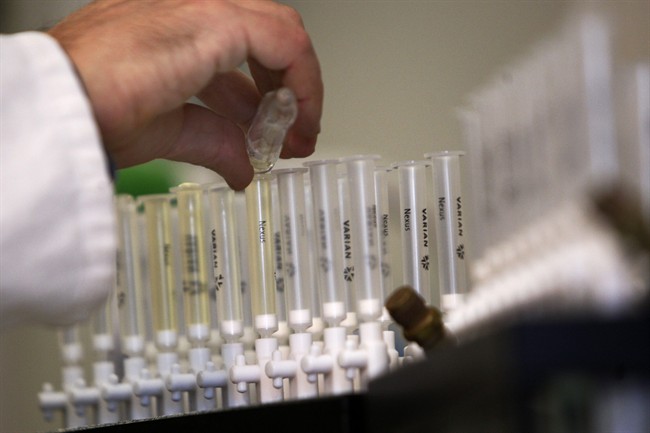TORONTO — By the time the Olympics wrap up in Sochi, some 2,500 drug tests will have been conducted — and that’s not including the rigorous testing athletes are subjected to before and after the Winter Games.

And in the final days in Sochi, a German athlete has failed a drug test in the first announced doping case at the 2014 Olympics.
On Friday, German Olympic officials say they notified the IOC that one of their athletes tested positive for doping. The athlete wasn’t named and neither was the substance involved.
Any athlete found guilty of doping violation faces disqualification and removal of results and medals.
READ MORE: German athlete tests positive at Sochi Olympics
This year, Olympic officials say they’ve dropped the gauntlet on doping, presenting the “most stringent” measures the global sporting event has ever seen.
Yet there are murmurs of a new “undetectable” doping agent called MGF — a therapy that boosts muscle growth and is classified as “highly effective,” at least that’s according to a German undercover investigation that reported on the alleged drug that could be circulating in Sochi.
Journalists with the German broadcaster WDR say they met with a scientist in Moscow who said he had a potent drug on hand — the German reporters say they even posed as consultants for German Olympic athletes and received samples of the miracle drug, according to Vice.
Canadian experts say these anecdotes aren’t as uncommon as we’d like to think.
“I think it’s fair to say that it does happen. Absolutely, there’s a black market of products,” Dr. Andrew Pipe said. But the University of Ottawa Heart Institute doctor and doping expert says that it’s just during Olympics that these issues are thrown into the spotlight.
“The public becomes much more attuned to these issues, and interested in these stories. Every major international sporting event tends to create a heightened sense of awareness,” Pipe said.

Get weekly health news
He’s at Sochi now as chair of the Olympic medical group – this is his 11th Olympics he’s been to.
READ MORE: Explainer – Lance Armstrong’s doping drugs
For Paul Melia, and the Canadian Centre for Ethics in Sports, closing the gap on any doping loopholes is a year-round initiative.
“It’s a huge concern for sports because if we don’t get a handle on it, if we don’t do everything we can to stop athletes from cheating by doping, it undermines the integrity of the sport,” Melia, the president and CEO of the CCES, told Global News. The CCES is the national body that runs Canada’s anti-doping programs and protects athletic integrity.
Are certain sports prone to doping?
“No sport is immune from the temptation to dope to gain a competitive advantage,” Melia said. But there are certainly some sports that tend to have a higher risk, and they’re usually the ones that involve strength and endurance.
In the Winter Games, Melia points to bobsleigh and cross-country skiing — testosterone or human growth hormones could be used to manipulate muscle-building. Athletes could use EPO to increase oxygen or use beta blockers to help slow the heartbeat and reduce tremors during shooting in a biathlon competition, for example.
Sochi 2014 complete coverage: Beyond the Podium
Most of the banned substances originate from legitimate pharmaceutical research and are used to treat medical conditions. Cancer patients could be dealing with muscle atrophy and turn to these muscle-building therapies. People with anemia could rely on EPO to stimulate the production of red blood cells. Instead, athletes could be using it to increase their oxygen-carrying capacity.
It could start with a scientist or doctor and end up in the hands of an athlete putting their career at risk for a competitive edge.
Cracking down on doping
But both experts say that for those tempted to dope, the game of evading current measures is becoming more difficult to play.
For starters, contemporary anti-doping measures have taken on an “intelligence-based approach.” Athletes are monitored but so are the importation and exportation of prohibited drugs. There’s participation between international police bodies and even postal services. The CCES even unveiled an anonymous hotline to collect information from the sports community.
READ MORE: Interpol to help sniff out crime at Olympics
“There is much more coordination and cooperation than there was five to 10 years ago. It’s a very different world in an anti-doping perspective,” Pipe said.
In recent Olympics, officials realized that doping isn’t necessarily saved just for game day: it could be used during training then weaned out of your system before the big event. That’s why athletes are tested year-round now and out of competition, Melia said.
Athlete biological passports — ABPs — have also been implemented. Think of them as identity cards containing each athlete’s blood profile in its uninterrupted state. Athletes are tested at random and often to create a baseline of what their typical blood makeup looks like — after that, officials can easily detect an aberration.
READ MORE: The Olympic victory stance: the universal sign of pride or dominance?
Future technology in testing for doping can even be applied to previous blood samples, Pipe said.
“We will have the opportunity to apply tomorrow’s scientific techniques to analyzing today’s samples and to a thinking athlete, that’s a pretty powerful deterrent,” Pipe said.
The samples taken from Sochi can be shelved for 10 years. That means that if 2024 technology finds an athlete guilty of doping, a medal from the 2014 Games could be rescinded.
“Those are the kinds of developments that lead one to say appropriately and accurately that there’s a more robust, more rigorous approach to doing control at these Games than has ever been the case before,” Pipe said.
Last year – from April 2012 to March 2013 – there were 19 reported anti-doping rule violations, according to the CCES. Once an athlete’s sanction period ends, they’re eligible to return to any sport under the anti-doping program.
carmen.chai@globalnews.ca
Follow @Carmen_Chai







Comments